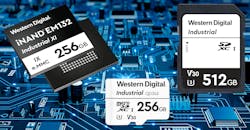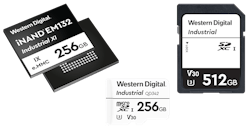Embedded developers usually have more demanding requirements than consumer products, where 3D NAND flash has taken the world by storm. It has made solid-state drives (SSDs) the norm, pushing hard-disk drives (HDDs) to the side. Likewise, embedded developers tend to prefer flash storage, but the capacities and price for single-level-cell (SLC) flash has been expensive.
Western Digital is well-known for its consumer and enterprise storage solutions. The company’s latest embedded products include rugged e.MMC, SD card, and MicroSD devices that are built using 64-layer 3D NAND flash (see figure).
Western Digital’s new 3D NAND flash storage includes e.MMC iNAND EM132 (left), the microSD (center), and SD card (right) form factors.
The e.MMC iNAND EM132 EFD chips come in capacities up to 256 GB. They meet the e.MMC 5.1 standard that supports backward compatibility. The standard version supports a temperature range of –25 to +85°C, while the extended temperature range pushes the lower limit to −40°C. As a result, the devices can be used in demanding application areas such as automotive.
The high-endurance, triple-level-cell (TLC) flash memory is rated at 3K program/erase cycles and write endurance of 693 TB. Sequential read/write performance is 310/150 MB/s with random read/write IOPS of 20K/12.5K. The chips support smart partitioning and manual refresh, as well as provide an advanced health reporting system. The commercial-grade products include enhanced user data area support. The chips come in an 11.5- × 13-mm package.
The SD card solution is available in both temperature ranges in capacities up to 512 GB; the endurance is rated at 1536 TB. It has a mechanical write protect switch. Features include a programmable ID, host lock support, secure firmware upgrade capability, error correction, and health status meter support. Sequential read/write speeds are 100/50 MB/s.
The industrial-grade microSD cards are available with the same temperature ranges as the EM132 EFD. They also come in capacities up to 256 GB with a write endurance up to 768 TB. As with the SD cards, the microSD features include a programmable ID, host lock support, secure firmware upgrade capability, error correction, and health status meter support. The cards achieve Speed Class 10, U1/U3, and V10/V30 performance with sequential read/write speeds of 100/50 MB/s.
About the Author
William G. Wong
Senior Content Director - Electronic Design and Microwaves & RF
I am Editor of Electronic Design focusing on embedded, software, and systems. As Senior Content Director, I also manage Microwaves & RF and I work with a great team of editors to provide engineers, programmers, developers and technical managers with interesting and useful articles and videos on a regular basis. Check out our free newsletters to see the latest content.
You can send press releases for new products for possible coverage on the website. I am also interested in receiving contributed articles for publishing on our website. Use our template and send to me along with a signed release form.
Check out my blog, AltEmbedded on Electronic Design, as well as his latest articles on this site that are listed below.
You can visit my social media via these links:
- AltEmbedded on Electronic Design
- Bill Wong on Facebook
- @AltEmbedded on Twitter
- Bill Wong on LinkedIn
I earned a Bachelor of Electrical Engineering at the Georgia Institute of Technology and a Masters in Computer Science from Rutgers University. I still do a bit of programming using everything from C and C++ to Rust and Ada/SPARK. I do a bit of PHP programming for Drupal websites. I have posted a few Drupal modules.
I still get a hand on software and electronic hardware. Some of this can be found on our Kit Close-Up video series. You can also see me on many of our TechXchange Talk videos. I am interested in a range of projects from robotics to artificial intelligence.



